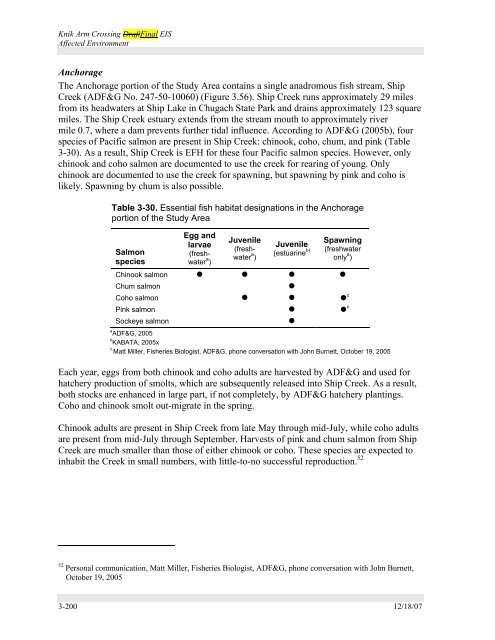3.0 Affected Environment - Knik Arm Bridge and Toll Authority
3.0 Affected Environment - Knik Arm Bridge and Toll Authority
3.0 Affected Environment - Knik Arm Bridge and Toll Authority
Create successful ePaper yourself
Turn your PDF publications into a flip-book with our unique Google optimized e-Paper software.
<strong>Knik</strong> <strong>Arm</strong> Crossing DraftFinal EIS<br />
<strong>Affected</strong> <strong>Environment</strong><br />
Anchorage<br />
The Anchorage portion of the Study Area contains a single anadromous fish stream, Ship<br />
Creek (ADF&G No. 247-50-10060) (Figure 3.56). Ship Creek runs approximately 29 miles<br />
from its headwaters at Ship Lake in Chugach State Park <strong>and</strong> drains approximately 123 square<br />
miles. The Ship Creek estuary extends from the stream mouth to approximately river<br />
mile 0.7, where a dam prevents further tidal influence. According to ADF&G (2005b), four<br />
species of Pacific salmon are present in Ship Creek: chinook, coho, chum, <strong>and</strong> pink (Table<br />
3-30). As a result, Ship Creek is EFH for these four Pacific salmon species. However, only<br />
chinook <strong>and</strong> coho salmon are documented to use the creek for rearing of young. Only<br />
chinook are documented to use the creek for spawning, but spawning by pink <strong>and</strong> coho is<br />
likely. Spawning by chum is also possible.<br />
Table 3-30. Essential fish habitat designations in the Anchorage<br />
portion of the Study Area<br />
Salmon<br />
species<br />
Egg <strong>and</strong><br />
larvae<br />
(freshwater<br />
a )<br />
Juvenile<br />
(freshwater<br />
a )<br />
Juvenile<br />
(estuarine b)<br />
Spawning<br />
(freshwater<br />
only a )<br />
Chinook salmon • • • •<br />
Chum salmon<br />
•<br />
Coho salmon • • • c<br />
Pink salmon • • c<br />
Sockeye salmon<br />
•<br />
a<br />
ADF&G, 2005<br />
b<br />
KABATA, 2005x<br />
c<br />
Matt Miller, Fisheries Biologist, ADF&G, phone conversation with John Burnett, October 19, 2005<br />
Each year, eggs from both chinook <strong>and</strong> coho adults are harvested by ADF&G <strong>and</strong> used for<br />
hatchery production of smolts, which are subsequently released into Ship Creek. As a result,<br />
both stocks are enhanced in large part, if not completely, by ADF&G hatchery plantings.<br />
Coho <strong>and</strong> chinook smolt out-migrate in the spring.<br />
Chinook adults are present in Ship Creek from late May through mid-July, while coho adults<br />
are present from mid-July through September. Harvests of pink <strong>and</strong> chum salmon from Ship<br />
Creek are much smaller than those of either chinook or coho. These species are expected to<br />
inhabit the Creek in small numbers, with little-to-no successful reproduction. 52<br />
52 Personal communication, Matt Miller, Fisheries Biologist, ADF&G, phone conversation with John Burnett,<br />
October 19, 2005<br />
3-200 12/18/07
















